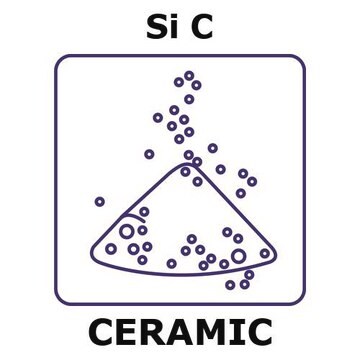594911
Silicon carbide
nanopowder, <100 nm particle size
Sinonimo/i:
Carbon silicide, Carborundum, Methanidylidynesilanylium, Silicon monocarbide
About This Item
Prodotti consigliati
Stato
nanopowder
Livello qualitativo
Area superficiale
70-90 m2/g
Dimensione particelle
<100 nm
Punto di fusione
2700 °C (lit.)
Densità
3.22 g/mL at 25 °C (lit.)
Densità bulk
0.069 g/cm3
Stringa SMILE
[C-]#[Si+]
InChI
1S/CSi/c1-2
HBMJWWWQQXIZIP-UHFFFAOYSA-N
Cerchi prodotti simili? Visita Guida al confronto tra prodotti
Categorie correlate
Descrizione generale
Applicazioni
- Overview of silicon carbide power devices: This document provides a comprehensive review of the characteristics and applications of silicon carbide (SiC) in power devices, discussing its advantages over traditional silicon devices in handling high voltages and efficiencies (Choi, 2016).
Stato fisico
Codice della classe di stoccaggio
11 - Combustible Solids
Classe di pericolosità dell'acqua (WGK)
nwg
Punto d’infiammabilità (°F)
Not applicable
Punto d’infiammabilità (°C)
Not applicable
Dispositivi di protezione individuale
dust mask type N95 (US), Eyeshields, Gloves
Scegli una delle versioni più recenti:
Possiedi già questo prodotto?
I documenti relativi ai prodotti acquistati recentemente sono disponibili nell’Archivio dei documenti.
I clienti hanno visto anche
Articoli
Composite materials that traditionally incorporate micron scale reinforcements in a bulk matrix offer opportunities to tailor material properties such as hardness, tensile strength, ductility, density, thermal and electrical conductivity, and wear resistance.
Silica is a very popular inorganic nanomaterial used in a wide range of applications including fillers for rubber, catalyst supports, separation media, carriers in food and agriculture, and abrasive/anticaking agents in cosmetics. It is also widely believed to be an important material for biomedical applications for following reasons.
Advanced Inorganic Materials for Solid State Lighting
Il team dei nostri ricercatori vanta grande esperienza in tutte le aree della ricerca quali Life Science, scienza dei materiali, sintesi chimica, cromatografia, discipline analitiche, ecc..
Contatta l'Assistenza Tecnica.



